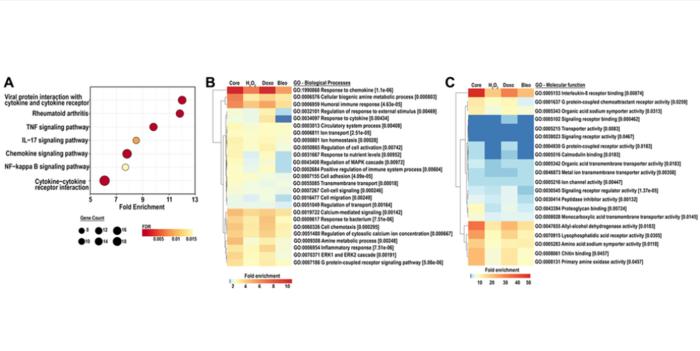“[…] despite the impact of aging on colon health and colon cancer, an atlas of the SASP produced by colon fibroblasts has not been established.”

Credit: 2024 Hattangady et al.
“[…] despite the impact of aging on colon health and colon cancer, an atlas of the SASP produced by colon fibroblasts has not been established.”
BUFFALO, NY- February 29, 2024 – A new research paper was published on the cover of Aging (listed by MEDLINE/PubMed as “Aging (Albany NY)” and “Aging-US” by Web of Science) Volume 16, Issue 4, entitled, “Mapping the core senescence phenotype of primary human colon fibroblasts.”
Advanced age is the largest risk factor for many diseases and several types of cancer, including colorectal cancer (CRC). Senescent cells are known to accumulate with age in various tissues, where they can modulate the surrounding tissue microenvironment through their senescence associated secretory phenotype (SASP). Recently, researchers showed that there is an increased number of senescent cells in the colons of CRC patients and demonstrated that senescent fibroblasts and their SASP create microniches in the colon that are conducive to CRC onset and progression. However, the composition of the SASP is heterogenous and cell-specific, and the precise senescence profile of colon fibroblasts has not been well-defined.
In this new study, to generate a SASP atlas of human colon fibroblasts, researchers Namita Ganesh Hattangady, Kelly Carter, Brett Maroni-Rana, Ting Wang, Jessica Lee Ayers, Ming Yu, and William M. Grady from Fred Hutchinson Cancer Center and the University of Washington School of Medicine induced senescence in primary human colon fibroblasts using various in vitro methods and assessed the resulting transcriptome.
“[…] we utilized various relevant stressors to induce senescence in primary cultures of colon fibroblasts and perform RNA sequencing (RNASeq) to define an atlas of stressor-specific senescent profiles and a core senescent profile that is commonly regulated by all senescence inducers.”
Using RNA Sequencing and further validation by quantitative RT-PCR and Luminex assays, the team define and validate a ‘core senescent profile’ that might play a significant role in shaping the colon microenvironment. They also performed KEGG analysis and GO analyses to identify key pathways and biological processes that are differentially regulated in colon fibroblast senescence. These studies provide insights into potential driver proteins involved in senescence-associated diseases, like CRC, which may lead to therapies to improve overall health in the elderly and to prevent CRC.
“Further studies will be needed to address the limitations of our study and to translate our understanding of the SASP and disease into clinical care.”
Read the full study: DOI: https://doi.org/10.18632/aging.205577
Corresponding Authors: William M. Grady, Ming Yu – [email protected], [email protected]
Keywords: senescence, senescence-associated secretory phenotype, SASP, colorectal cancer, cancer
Click here to sign up for free Altmetric alerts about this article.
About Aging:
Launched in 2009, Aging (Aging-US) publishes papers of general interest and biological significance in all fields of aging research and age-related diseases, including cancer—and now, with a special focus on COVID-19 vulnerability as an age-dependent syndrome. Topics in Aging go beyond traditional gerontology, including, but not limited to, cellular and molecular biology, human age-related diseases, pathology in model organisms, signal transduction pathways (e.g., p53, sirtuins, and PI-3K/AKT/mTOR, among others), and approaches to modulating these signaling pathways.
Please visit our website at www.Aging-US.com and connect with us:
- X, formerly Twitter
- YouTube
- Spotify, and available wherever you listen to podcasts
Click here to subscribe to Aging publication updates.
For media inquiries, please contact [email protected].
Aging (Aging-US) Journal Office
6666 E. Quaker Str., Suite 1B
Orchard Park, NY 14127
Phone: 1-800-922-0957, option 1
###
Journal
Aging-US
DOI
10.18632/aging.205577
Method of Research
Data/statistical analysis
Subject of Research
People
Article Title
Mapping the core senescence phenotype of primary human colon fibroblasts
Article Publication Date
21-Feb-2024




